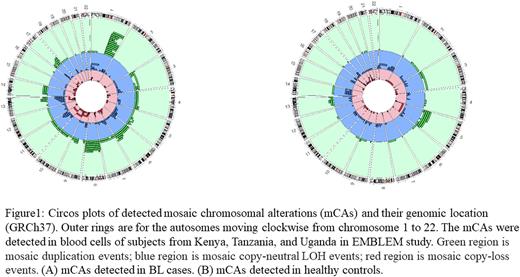Abstract
Introduction: Burkitt lymphoma (BL) is an aggressive B-cell lymphoma with reciprocal IG∷MYC translocations and accounts for 50-75% of childhood cancers in sub-Saharan Africa. Mosaic chromosomal alterations (mCAs) are large, somatically acquired structural chromosomal alterations that are clonal and observed in detectable fractions of circulating mononuclear cells. mCAs have been linked to increased hematologic cancer risk, but their association with BL, a mononuclear B cell tumor, is unknown. We hypothesized that the frequency and distribution of mCAs in peripheral leukocytes would be elevated in children with BL, potentially serving as a biomarker of chromosomal instability relevant to BL risk.
Methods: We investigated peripheral leukocyte DNA extracted from children enrolled in the Epidemiology of Burkitt Lymphoma in East African Children and Minors (EMBLEM) study (2010-2016) and the Infections and Childhood Cancer case-control study conducted in Malawi (2005-2010). We used genome-wide single nucleotide polymorphism (SNP) array data to investigate the frequency, type, and distribution of mCAs >2Mb in size detected in peripheral leukocytes of 931 pediatric BL cases with 3,645 healthy children in Uganda, Tanzania, and Kenya, and with 177 non-BL pediatric cancers in Malawi. Eagle2 and SHAPEIT4 software were used for phasing to infer haplotypes for SNP array data and WGS data. MoChA (v2014-05-14) was used to detect mCAs. Parallel analysis using similar methods was performed on whole genome sequences (WGS) from paired tumor-normal blood samples from two Ugandan BL patients from the BL Genome Sequencing Project (BLGSP) and from paired BL- and lymphoblastoid-derived cell lines.
Results: Most samples (92%) were from the EMBLEM study, whereas 8% were from Malawi. The mean age of the BL cases and controls was similar (~7.4 years in both, P=0.60). Table 1 shows detected autosomal mCAs for BL cases and controls by country. Overall, a total of 250 autosomal mCAs were detected in 78 (8.4%) of the 931 BL cases. By comparison, a total of 188 autosomal mCAs were detected in 131 (3.4%) of the 3822 controls. Autosomal mCAs were detected in cell fractions ranging from 0.5% to 99.2% (Figure S1). The average number of autosomal mCAs per person (i.e., total of mCAs detected/number of individuals with mCAs detected) was higher in the BL cases compared to controls (3.21 [SD 3.24] versus 1.44 [SD 2.31], P-value=4.50×10-5. The higher frequency of mCAs in blood samples of children with BL compared to controls was independent of age, sex, P falciparum status, and country (OR=2.8, 95% CI=2.06-3.81, P-value=5.70×10-11, Table 1. mCAs on the X chromosome in girls were also associated with BL (5% versus 1.7%, OR=3.12, 95% CI=1.47-6.29, P-value=1.65×10-3). We did not observe an association for mCAs on the Y chromosome in boys. Analysis of paired tumor-normal samples confirmed the presence of the IG∷MYC translocation in tumor, but the same pipelines did not detect the translocation in the corresponding normal blood sample. In informative tumor-normal cases, some mCAs were only detected in tumor, others were detected in both tumor and normal blood, whereas others were detected mCAs in normal only suggesting some mCAs in blood could arise from pre-BL clones. mCAs only observed in BL cases were predominantly gains on chromosome 1q and 8 (Figure 1) which contain major drivers of Burkitt lymphomagenesis including PLEKHO1, MCL1, PSMB4, ILF2, HAX1, ATP8B2 and CKS1B.Conclusion: We report a high frequency of mCAs in healthy sub-Saharan African children and even higher frequency in pediatric BL cases. The mCAs in children with BL clustered on chromosomes 1q and 8 in regions that overlap with several significantly mutated BL genes, suggesting that mCAs may be potential biomarkers important in the natural history of BL. Using paired tumor-normal sample WGS data, we report both similar and unique mCAs in the paired samples suggesting pre-BL clones in blood. These methods are scalable to large cohorts with SNP array data to investigate health effects associated with mCAs in Africa.
Disclosures
No relevant conflicts of interest to declare.
Author notes
Asterisk with author names denotes non-ASH members.


This feature is available to Subscribers Only
Sign In or Create an Account Close Modal